- Understanding the Power of Digital Business Transformation: Why It’s Necessary?
- Understanding the Average Digital Transformation Cost
- Factors Affecting the Digital Transformation Costs for Businesses
- Technology Infrastructure
- Technology Stack Integrations
- Organization Size
- Existing Digital Skills Gaps
- Business Goals
- Legacy System Integration
- Regulatory Compliance and Security
- Scalability and Future-Proofing
- Customer Experience Enhancements
- Hidden Costs Impacting the Average Cost of Digital Transformation
- Customization and Integration Costs
- Data Migration Costs
- Change Management Costs
- Training and Upskilling
- Vendor Management and Licensing Fees
- Performance Monitoring and Optimization
- Cybersecurity and Compliance Overheads
- Ongoing Software Updates and Maintenance
- Opportunity Costs
- Best Practices and Technology Implications to Reduce Business Transformation Costs
- Cloud Hosting and Migration
- Automation Tools
- IoT (Internet of Things) Integration
- Team Management Tools
- Shipping and Logistics Tools
- AI-Driven Analytics and Decision-Making Tools
- Digital Collaboration and Communication Tools
- Digital Marketing Automation Tools
- Blockchain for Secure Transactions
- How to Implement Digital Transformation Strategies Effectively
- 1. Plan and Prioritize Your Digital Transformation Initiatives
- 2. Align Teams and Stakeholders
- 3. Leverage Agile Methodologies for Implementation
- 4. Measure and Track Success
- 5. Mitigate Risks and Overcome Roadblocks
- Five Digital Transformation Industry Use Cases For Understanding Cost Management
- Supply Chain and Manufacturing Industry for Social Distancing With an Automation Process
- Digital Healthcare Industry to Keep Spaces Safe
- eCommerce Industry Creating More Engaging Shopping Space
- Food Industry Delivering Successful Customer Experience
- How Can Appinventiv Help You With Digital Transformation?
- FAQs
Key takeaways:
- Digital transformation is essential for staying competitive.
- Costs vary, from $50,000 to $5 million+, depending on scope.
- Hidden costs like data migration and customization can add up.
- Cloud and automation can significantly reduce operational costs.
- AI and analytics improve efficiency and drive ROI.
- Timely action is key to gaining a competitive edge.
Digital transformation is no longer a buzzword—it’s a business imperative.
But for business leaders, the path to modernization often comes with a frustrating paradox: you know your organization must go digital to stay competitive, yet the cost of doing so can be vague, unpredictable, and potentially overwhelming.
You’re not alone if you’re asking:
- How much will this transformation truly cost us?
- What parts of the business will require the biggest investment?
- How can I ensure the spend leads to measurable outcomes—not sunk costs?
These are critical concerns, especially in a landscape where cost pressures are mounting, IT budgets are scrutinized, and every digital initiative needs to prove its ROI.
So, what’s the ballpark?
Depending on your organization’s size, complexity, and goals, digital transformation costs can range from $50,000 for smaller initiatives to $500,000+ for enterprise-wide overhauls. Variables like legacy system upgrades, cloud migration, workforce re-skilling, cybersecurity integration, and data platform modernization all impact the final spend.
To navigate these complexities, a thorough digital transformation cost benefit analysis is essential. This ensures that each dollar spent is tied directly to tangible business value—whether through improved efficiency, reduced overhead, or enhanced customer experience.
But here’s the truth: the price tag alone doesn’t define success. It’s the value you extract from that investment—improved efficiency, reduced operational overhead, better customer experiences—that truly matters.
In this blog, we’ll help you decode the cost puzzle of digital transformation. From key cost drivers and savings levers to real-world use cases and strategy models, we break down everything you need to know to make informed, ROI-driven decisions about your digital future.
Let’s dive in.
Understanding the Power of Digital Business Transformation: Why It’s Necessary?
In 2025 and beyond, staying relevant isn’t just about keeping up with trends; it’s about leading the charge with digital transformation. For businesses, this is the defining challenge of our time. Every decision you make now will either position you as a market leader or leave you scrambling to catch up.
It’s no longer enough to simply talk about digital transformation—it’s something you must live and breathe. The question isn’t whether you should transform, but how soon you can get started. And if you haven’t already? You’re not just falling behind; you’re risking being left in the dust.
Recent data underscores the critical need for digital transformation:
- IDC projects that global spending on digital transformation will approach $4 trillion by 2027, growing at a compound annual growth rate (CAGR) of 16.2% .
- McKinsey reports that 90% of organizations are currently undergoing some form of digital transformation, emphasizing its centrality to long-term business strategy .
- PwC’s Global CEO Survey indicates that 70% of business leaders believe generative AI will significantly change how their businesses create, deliver, and capture value .
Now, based on the latest digital transformation statistics and market trends, the current landscape presents a unique opportunity for organizations to embark on their digital transformation journeys. With significant investments flowing into digital technologies and AI, the window for gaining a competitive edge is open. However, timely action is crucial; delaying transformation could result in missed opportunities and increased difficulty in catching up with digitally advanced competitors.
In the following sections, we will delve into the costs associated with digital transformation, providing insights into budgeting, potential returns, and strategic considerations to guide your organization’s journey toward a digital future.
Understanding the Average Digital Transformation Cost
As revealed earlier, the average cost of digital transformation can vary significantly depending on the size, complexity, and specific goals of the organization. While it’s tempting to search for a one-size-fits-all answer, the reality is that digital transformation is an ongoing process that affects many aspects of a business. The key to getting an accurate cost estimate is understanding how different factors influence the budget and knowing the tools at your disposal to plan accordingly.
So, how do you estimate the costs for your digital transformation project?
To give you a clearer picture, there’s a straightforward formula that businesses can use to calculate their transformation budget:

Let’s look into what makes up these costs:
Technology Infrastructure: This includes costs associated with cloud services, new software, systems integration, cybersecurity measures, and technology upgrades.
Implementation: The cost of professional services, consultation, training, and change management required to roll out digital solutions.
Staffing & Talent: Expenses related to hiring or upskilling employees, especially if there’s a need for specialized roles like data scientists or AI experts.
Ongoing Maintenance & Optimization: These are recurring costs for software subscriptions, system updates, and continuous improvements.
To make things more concrete, let’s break down the typical cost ranges for different types of digital transformation efforts:
| Type of Transformation | Estimated Cost Breakdown for End-to-End Digital Transformation | Details |
|---|---|---|
| Small-Scale Digitalization | $50,000 – $250,000 | Implementing digital tools in specific business functions or upgrading existing systems. |
| Medium-Sized Transformation | $250,000 – $1 million | Business-wide technology integration with advanced systems and automation. |
| Enterprise-Wide Transformation | $1 million – $5 million+ | Large-scale overhaul, including multiple departments, new business models, and AI implementation. |
Let’s dive deeper into the top factors affecting digital transformation cost, including technology stack choices, required talent, and the operational complexities that businesses must navigate.
Factors Affecting the Digital Transformation Costs for Businesses
Numerous factors contribute to the total cost of the digital transformation process. The scope and scale of such an effort are influenced by multiple aspects within an organization:
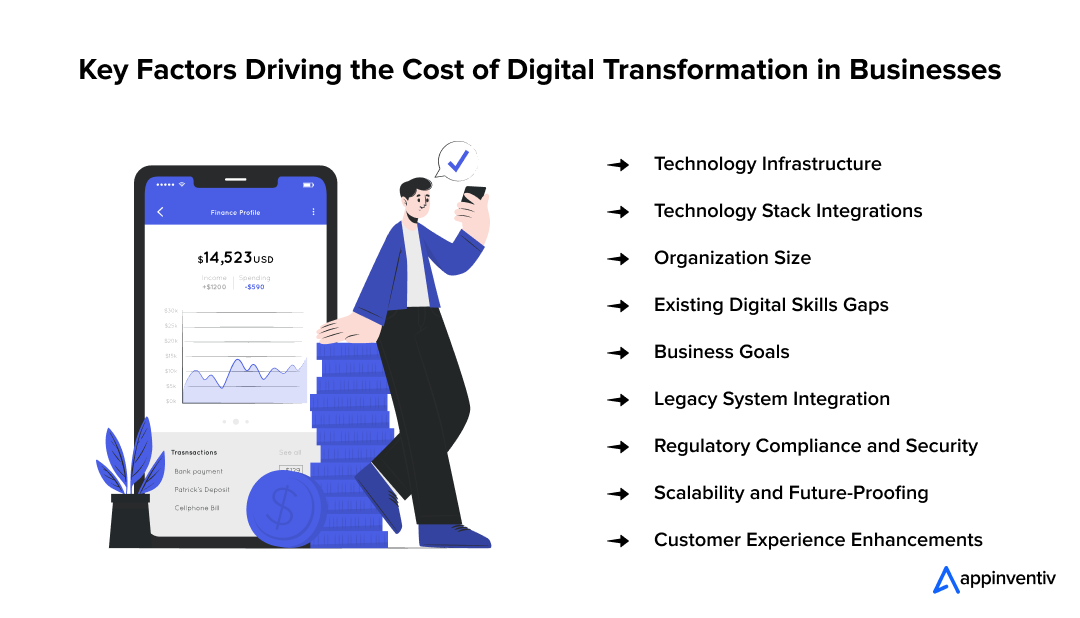
Technology Infrastructure
Upgrading or integrating new software, hardware, and networking infrastructure can lead to substantial costs. For example, consider a mid-sized e-commerce company seeking to expand its online marketplace by adopting a new customer relationship management (CRM) system. It will require investments in licensing fees, hardware enhancements, and software integrations.
Technology Stack Integrations
Integrating innovative technologies into existing workflows can result in significant expenses. For instance, when a healthcare organization decides to implement a new electronic health records (EHR) system, it may face additional costs due to the requirement for custom integrations and comprehensive staff training to ensure a smooth transition to the new system.
Organization Size
The organization’s size impacts various costs, such as software licenses, server bandwidth, training resources, and security measures. Implementing digital transformation across all subsidiaries and departments can result in higher expenditures for a multinational corporation with a diverse portfolio and global presence.
Existing Digital Skills Gaps
Training staff on new digital tools and processes to address skill gaps can add to the overall average cost of digital transformation. For example, when a traditional manufacturing company adopts Industry 4.0 technology, it needs to upskill its employees on automation and IoT technologies, resulting in training and development costs.
[Also Read: Digital Transformation in Manufacturing: Unlocking Efficiency and Innovation]
Business Goals
Significant investments are often necessary to align digital transformation initiatives with specific business objectives. For example, a financial institution that is transitioning to a digital banking model must invest in app development, data security, and customer service enhancements. These investments are crucial to ensure a smooth transition and meet customers’ evolving demands.
Legacy System Integration
Integrating legacy systems with modern technology can be a complex process that can increase the overall digital transformation costs. For instance, a transportation company looking to upgrade its fleet management may have to endure higher expenses due to the complexities involved in integrating legacy software with modern GPS tracking and management systems.
[Also Read: Legacy Application Modernization Strategy: A Comprehensive Guide to Revitalizing Your IT Infrastructure]
Regulatory Compliance and Security
Ensuring compliance and maintaining strong data security often requires substantial investment. Financial institutions undergoing digital transformation must navigate strict regulatory standards such as GDPR, PCI DSS, and ESG compliance mandates in the U.S., which focus on environmental, social, and governance responsibilities. These demands typically lead to significant spending on cybersecurity, sustainability initiatives, and regulatory alignment.
[Also Read: IT Compliance Regulations for US Industries: Navigate Compliance with Confidence]
Scalability and Future-Proofing
Scalability is essential when considering the long-term cost of digital transformation. Businesses need to invest in technologies that not only meet current requirements but also grow with their needs. Investing in cloud-based platforms, scalable software solutions, and flexible infrastructure can optimize long-term costs by enabling businesses to scale more easily as they grow.
Customer Experience Enhancements
Investing in digital tools that enhance customer experience, such as AI-powered chatbots, personalized marketing, or customer service automation, can add significant costs. While these technologies drive customer satisfaction and loyalty, the initial setup and ongoing management may require substantial resources. For example, a retail company introducing an omnichannel shopping experience may face costs related to integrating online and offline platforms, implementing real-time inventory management, and personalizing customer interactions.
Hidden Costs Impacting the Average Cost of Digital Transformation
While the main expenses of digital transformation are often visible, there are several hidden costs that businesses tend to overlook. These costs, though not immediately apparent, can significantly impact the overall budget and timeline of the transformation process.
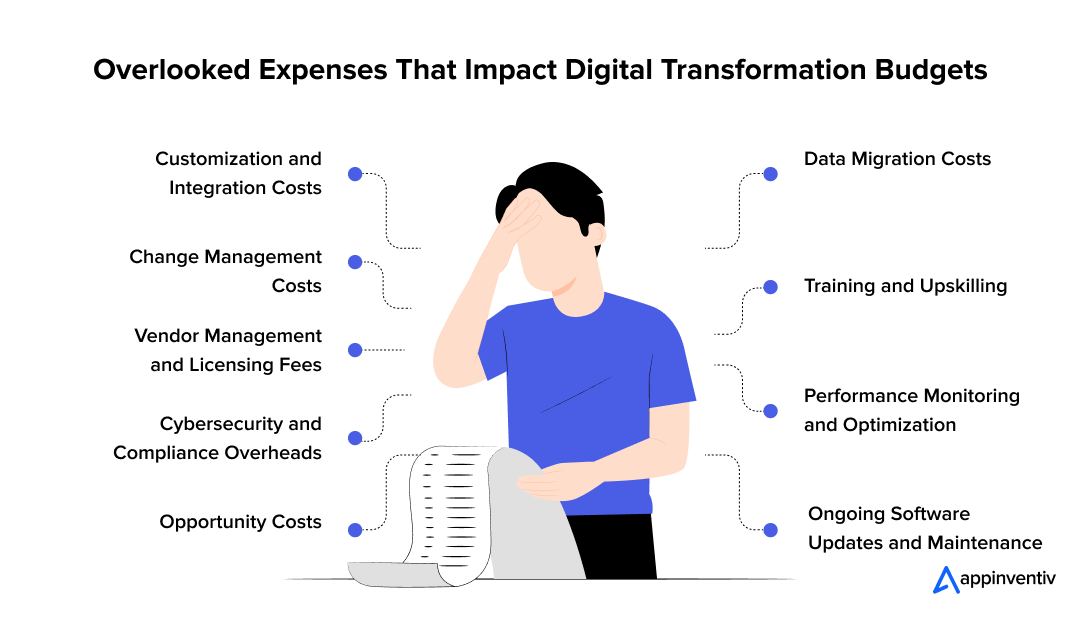
Customization and Integration Costs
Customizing new systems to integrate with legacy platforms or specific business needs can incur unforeseen expenses. These integration efforts may require additional development work and testing, which adds to the cost.
Data Migration Costs
Migrating existing data to new platforms often requires specialized tools and resources to ensure data integrity and security. This process can be time-consuming and costly, especially when dealing with large volumes of sensitive information.
[Also Read: Five Ways To Tackle Digital Transformation Without Downtime]
Change Management Costs
Ensuring successful adoption of new systems requires comprehensive change management strategies. This includes additional costs for communication, stakeholder buy-in, and the time spent on managing employee transitions.
Training and Upskilling
While staff training is necessary, it often takes more time and money than anticipated. The need for ongoing education and upskilling employees to effectively use new technologies can lead to continuous costs over the long term.
Vendor Management and Licensing Fees
Working with multiple vendors and licensing different technologies can lead to unexpected costs. Vendor fees, maintenance contracts, and subscription renewals often add up, especially when relying on third-party services for cloud, security, or CRM systems.
Performance Monitoring and Optimization
After the initial implementation, constant monitoring and fine-tuning of systems are essential to ensure optimal performance. The costs of monitoring tools, troubleshooting, and optimizing systems can be significant over time.
Cybersecurity and Compliance Overheads
With the introduction of new technologies comes the need for enhanced cybersecurity measures. Ensuring compliance with regulations, such as GDPR, can result in added costs for data protection measures, audits, and compliance reporting.
Ongoing Software Updates and Maintenance
Many businesses underestimate the cost of ongoing software updates and maintenance post-implementation. Regular patches, version upgrades, and new feature deployments can drive up the digital transformation costs over the course of a period.
Opportunity Costs
During the digital transformation, employees may be diverted from regular tasks, leading to decreased productivity. The opportunity cost of lost time and resources spent on the transformation can significantly impact revenue generation.
Best Practices and Technology Implications to Reduce Business Transformation Costs
Here are some of the digitally transforming tools and technology implications that can help you with digital transformation cost reduction while helping you leverage the digital transformation advantages effectively:

Cloud Hosting and Migration
Cloud adoption is the most significant step to accelerate enterprise digital transformation. By migrating to the cloud, businesses can centralize their operations, enabling data and resources to be accessed from one unified platform. This eliminates the need for expensive on-site infrastructure, reduces maintenance costs, and streamlines operations. Cloud hosting offers scalability, allowing companies to pay only for what they use, making it a cost-effective solution as businesses grow. Additionally, cloud environments enhance collaboration and data accessibility, saving time and reducing operational inefficiencies across departments.
Automation Tools
Enterprises of every scale and size widely adopt automation tools. For a business to survive, it constantly needs to focus on lowering operational costs, and that’s when automation tools come into action. They simplify workloads and mundane tasks and increase productivity by bringing efficient management. This helps them optimize the enterprise digital transformation costs effectively.
[Also Read: AI in Quality Assurance: The Next Stage of Automation Disruption]
IoT (Internet of Things) Integration
Emerging IoT technologies play a key role in how digitalization reduces cost. IoT helps prioritize and optimize inventory, revenue system, manufacturing, operational process, and energy management. IoT is the biggest source of predictive maintenance, 5G, and big data, decreasing interruptions and overall development costs.
Team Management Tools
Startups and enterprises are using applications such as Keka, Basecamp, Asanaises to manage tasks, projects, and teams efficiently. They enable tracking all initiatives in one system. These comprehensive management tools and software also significantly help in cost and resource management.
Shipping and Logistics Tools
Technological tools can be the backbone of delivery, purchase, and transportation. Digital tracking of shipping and logistics saves staff requirements and centralized product operations. This is another example of enterprise digital transformation cost reduction.
AI-Driven Analytics and Decision-Making Tools
AI and machine learning-driven analytics help businesses make more informed decisions and optimize processes. These tools enable predictive analysis of customer behavior, sales trends, and operational inefficiencies. By using data-driven insights, businesses can pinpoint areas of cost wastage and implement smarter, cost-effective solutions that minimize resource use and improve overall profitability.
Digital Collaboration and Communication Tools
Remote working and digital collaboration tools have become indispensable. Tools like Slack, Microsoft Teams, and Zoom help teams stay connected and productive, reducing the costs associated with in-person meetings, travel, and office space. These tools allow for real-time communication, file sharing, and project management, making collaboration seamless and cost-efficient.
Digital Marketing Automation Tools
Automating digital marketing through platforms like HubSpot, Marketo, or Mailchimp can lower marketing expenses while improving reach and personalization. These tools help automate campaigns, track customer interactions, and personalize communications, all of which result in reduced human effort and increased marketing efficiency. Automated campaigns also allow businesses to scale without multiplying marketing costs.
Blockchain for Secure Transactions
Blockchain technology is not only revolutionizing security but also reducing operational costs in transactions. By implementing blockchain for financial transactions and contracts, businesses can reduce the need for intermediaries, speed up processes, and minimize the potential for fraud. This can lead to significant savings, especially for businesses handling large volumes of transactions.
How to Implement Digital Transformation Strategies Effectively
Implementing digital transformation for businesses is more than just adopting new technology—it requires a structured strategy to ensure that the transformation aligns with business objectives, delivers measurable outcomes, and optimizes ROI. In this section, we’ll walk through the critical step-by-step process of digital transformation that businesses can take to successfully implement their digital journey, minimizing risks and ensuring seamless integration across operations.
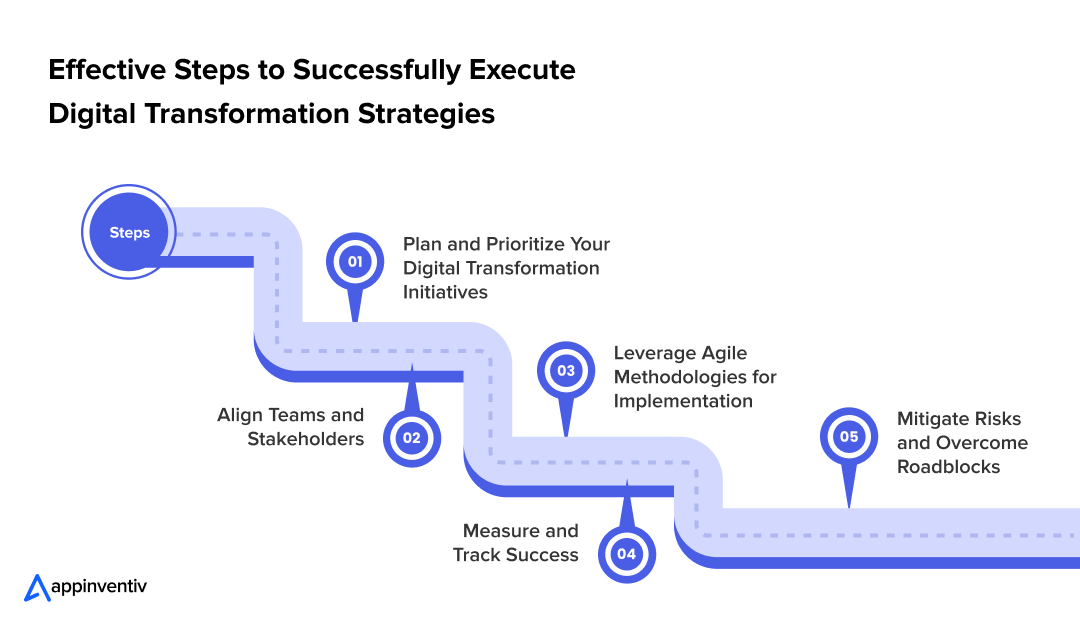
1. Plan and Prioritize Your Digital Transformation Initiatives
Before diving into the digital transformation process, it’s essential to outline a clear plan and prioritize initiatives that align with your business objectives. Start by identifying key areas of the business that will benefit the most from digitalization—whether it’s improving customer experiences, optimizing internal processes, or enhancing decision-making capabilities.
- Assess Current Systems: Evaluate your existing digital infrastructure to determine where updates or replacements are needed.
- Align With Business Goals: Ensure your transformation initiatives align with long-term business objectives such as increased efficiency, scalability, and profitability.
- Set Clear Milestones: Establish measurable milestones and timelines to track the progress of your transformation efforts.
2. Align Teams and Stakeholders
Successful digital transformation for businesses involves collaboration across multiple teams and departments. Ensuring all stakeholders are on the same page is crucial for maintaining momentum and avoiding setbacks.
- Leadership Buy-In: Secure support from C-suite executives and department heads who can provide the necessary resources and guide the transformation strategy.
- Cross-Functional Collaboration: Encourage communication between IT, operations, marketing, and customer service teams to ensure a unified approach.
- Training and Upskilling: Equip employees with the skills needed to work with new technologies, ensuring they’re comfortable and productive throughout the transition.
3. Leverage Agile Methodologies for Implementation
Agility is critical when implementing digital transformation. By adopting agile methodologies, businesses can iterate, adapt, and make necessary adjustments in real-time, reducing risks and delays.
- Phased Approach: Break down the transformation process into smaller, manageable phases. This allows you to focus on high-impact areas first and avoid overwhelming your team.
- Continuous Feedback: Regularly gather feedback from key stakeholders and employees to ensure the transformation is meeting their needs and expectations.
- Flexibility: Be open to course corrections. Digital transformation is a dynamic process, and staying flexible allows businesses to adapt to evolving needs and unforeseen challenges.
4. Measure and Track Success
Tracking progress is essential for ensuring that your digital transformation delivers the intended outcomes. Establish key performance indicators (KPIs) and benchmarks to monitor the success of your initiatives.
- Operational Efficiency: Measure improvements in operational costs, time savings, and resource utilization.
- Customer Experience: Monitor customer satisfaction through metrics like Net Promoter Score (NPS) or customer retention rates.
- Return on Investment (ROI): Calculate the ROI of your transformation efforts by comparing the costs of implementation with the revenue or savings generated.
5. Mitigate Risks and Overcome Roadblocks
Despite careful planning, digital transformation can come with its own set of challenges. Identifying potential risks early and developing strategies to address them will help mitigate delays and cost overruns.
- Data Security: Ensure that data protection is a priority, especially when integrating new technologies that store or process sensitive information.
- Integration Challenges: Be prepared for complications when integrating legacy systems with modern technologies. Invest in the right tools or external expertise to address integration issues.
- Change Management: Address resistance to change by implementing a strong change management strategy. Communicate the business benefits of digital transformation and provide support to employees as they adapt to new systems.
Let’s now look into a few real-time industry use cases of digital transformation adoption to understand how various business verticals adapt to modern technologies and leverage the expertise of a reputed IT consulting company to save costs.
Below are some of the successful digital transformation applications and practices that various industries follow to manage cost and scale.
Five Digital Transformation Industry Use Cases For Understanding Cost Management
Startups and enterprises are now looking at big numbers and opportunities by implementing various digital transformation strategies aligned to their industry needs. Here, we have listed real-time digital business transformation examples and practices businesses follow to manage their digital transformation costs in the long run.
Supply Chain and Manufacturing Industry for Social Distancing With an Automation Process
AI and IoT use cases are well known for digitally transforming the supply chain and manufacturing industry. We have talked about how IoT in manufacturing has been a massive help in breaking digital barriers. Bringing intelligence to the equipment on the factory floor has minimized the time humans spend in close proximity.
Manufacturing and related industries implemented WIP (Work In Progress) solutions with deep learning that helps in the quality control process. Another big execution in IoT is image processing and automation tools that have helped keep social distancing in check. These given technologies have helped the supply chain sector save over 40% on labor and associated processes.
One real-time example of executing a digital transformation strategy for the supply chain is Appinventiv, which designed an intelligent logistics and supply chain software solution to help the enterprise become more responsive to its customers’ needs. The solution resulted in a 60% increase in supply chain visibility and a 40% reduction in transportation and logistics costs.
Digital Healthcare Industry to Keep Spaces Safe
Innovation in the healthcare industry has been one of the most prominent examples of digital business transformation success. In the post-COVID world, combining AI with robotics has helped enhance patient monitoring, lab automation, neurosurgery, medical device packaging, and many other fields. Online healthcare applications have also kept patients and doctors in touch digitally.
Healthcare institutions also get the agility required to optimize operational processes while reducing costs.
One real-time digital business transformation example can be Appinventiv building a revolutionizing app solution, “YouCOMM,” to transform patient assistance in emergencies effectively. YouCOMM is now successfully running in various hospital chains, leading to a 60% growth in nurse response time.
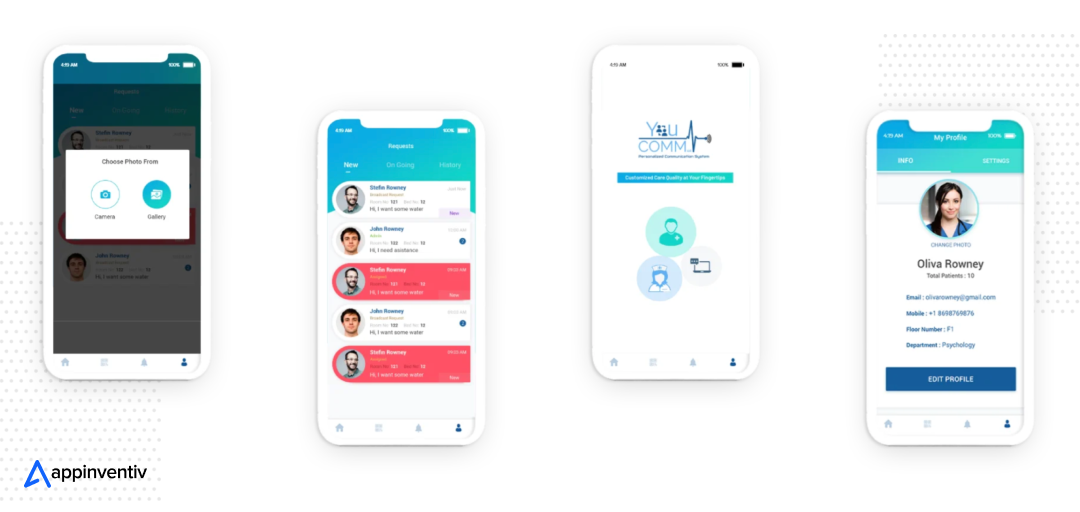
eCommerce Industry Creating More Engaging Shopping Space
Another industry that witnessed remarkable progress in digital transformation is the retail and eCommerce industry. Businesses use data and AI to refine customer experience, optimize operations and layouts, and refine product development.
In the world of social distancing, computer vision and Big Data are being used to track customer volumes in stores and help retailers maintain an engaging shopping space. Moreover, directly interacting with customers on your business platform (mobile apps) rather than on third-party websites can help you cut costs, offer better prices to customers, and generate better revenue.
Two popular instances of digital business transformation in eCommerce are Adidas and IKEA. Appinventiv curated a mobile app solution for Adidas to expand its global presence, resulting in over 2+ Million downloads.
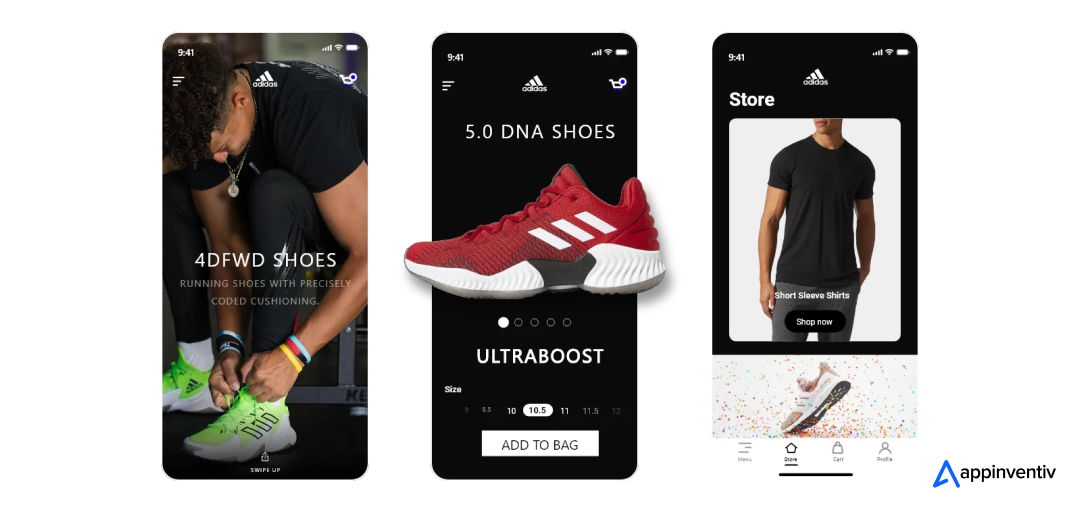
Furthermore, we designed an ERP solution for the world’s biggest furniture retailer, IKEA, to ease its customer onboarding process. Today, the ERP solution is expanded in more than 7+ IKEA stores across the UAE and is the biggest source of ROI measurement.

Food Industry Delivering Successful Customer Experience
The food and restaurant industry often struggles with customer retention due to unsatisfactory app experience, difficulty placing an order, or poor in-app user journey. A digital transformation business model of adopting enhanced and conceptualized food applications has helped the industry overcome major challenges.
Digital business transformation cost management examples for the food industry can be Appinventiv redefining Domino’s UI/UX strategy to increase its mobile app conversion rate by 23%.

Another instance is Appinventiv transforming the digital user journey of Pizza Hut through end-to-end mobile app development. The app has over 50k+ downloads and an increased conversion rate of 30%.

How we act today is how we will be remembered in the future. Making the right decisions is an absolute necessity today, and the right way to innovate through your business is by adopting digital transformation. However, ensure you have a reliable technical partner for optimizing business processes, automating systems, and propelling innovation.
[Discover how Appinventiv solves digital transformation challenges that pull businesses down.]
How Can Appinventiv Help You With Digital Transformation?
Appinventiv is a leading digital transformation services company dedicated to assisting businesses in achieving measurable outcomes and establishing agile procedures through tailored solutions aligned with the assessment of their current capabilities.
We redefine how you engage with your current and prospective clientele, enhancing your adaptability to market trends and mastering the application of the latest and emerging technologies for your business, among various other benefits.
Furthermore, we are committed to assisting in reducing the enterprise digital transformation cost by employing expertise and innovative solutions. With our seasoned team of professionals, we conduct comprehensive analyses of your current systems and business operations. Our dedicated digital transformation strategy can pinpoint areas where cost reductions and operational improvements can be made by identifying redundancies, gaps, and inefficiencies.
Through strategic planning and the implementation of streamlined and efficient technologies, we aim to optimize your systems and processes. Our tailored strategies are designed to help you achieve operational efficiency and cut down unnecessary expenses, enabling you to invest more effectively in digital transformation.
Collaborate with us to harness cutting-edge technological solutions that can help you effectively optimize costs across your digital transformation journey.
FAQs
Q. How much does digital transformation cost?
A. Digital transformation costs vary based on your company’s size, complexity, and objectives. For smaller projects, it can range from $50,000, while large-scale transformations can exceed $500,000. The total cost is influenced by factors like legacy system upgrades, cloud migration, cybersecurity integration, and talent development. Each initiative’s scale and technology choices will significantly impact the final spend.
Q. Why is digital transformation important?
A. Digital transformation is crucial for staying competitive and future-proofing your business. It helps companies streamline operations, improve customer experiences, and drive innovation. Embracing new technologies allows businesses to operate more efficiently, increase scalability, and adapt to evolving market needs.
Q. How to optimize digital transformation costs?
A. To optimize digital transformation costs, businesses can:
- Adopt cloud hosting to reduce infrastructure and maintenance expenses.
- Leverage automation tools to streamline processes and reduce labor costs.
- Prioritize scalable solutions that grow with your business, minimizing future reinvestments.
- Integrate AI and analytics to drive smarter decision-making and improve efficiency.
- Use phased implementation to spread out costs and manage the transition smoothly.
Q. Can digital transformation reduce spending?
A. Digital transformation has the potential to reduce overall costs by improving business processes and operations. Through automation, streamlined workflows, and the adoption of modern technologies, companies can reduce costs associated with manual labor and inefficient processes. Additionally, optimizing workflows, eliminating redundancies, and increasing productivity can result in long-term digital transformation cost savings across different business functions.



10 Use Cases and Benefits of Adopting Digital Twins in Retail
Retail is a vibrant arena, full of opportunity but fraught with challenges. As consumers become more demanding and competition gets fierce, retailers face mounting pressures. From unpredictable consumer demands and ever-changing market trends to supply chain disruptions and the need for personalized customer experiences, there is so much to grapple with. It is a juggling…

Exploring the Impact of Digital Transformation on the Pharma Industry
Digital transformation today is shaking things up in the pharmaceutical world. You might be wondering, What’s the big deal? Well, think of it as the tech revolution for pharma—a game-changer, reshaping everything from drug development to clinical trials and patient interactions. With innovations like machine learning, artificial intelligence, and big data analytics, the industry is…

Automotive Digital Transformation - Benefits, Use Cases and Challenges for Modern Businesses
With qualitative products, customers have shifted their focus towards the experiences they receive from you. These spot-on transactional experiences help them build a strong brand perception for your business, making them loyal. And 46% of consumers say they would pay more to purchase from trustworthy brands. Thus, the exceptional customer experience is a key driver…

















